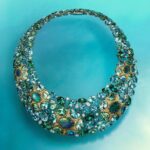
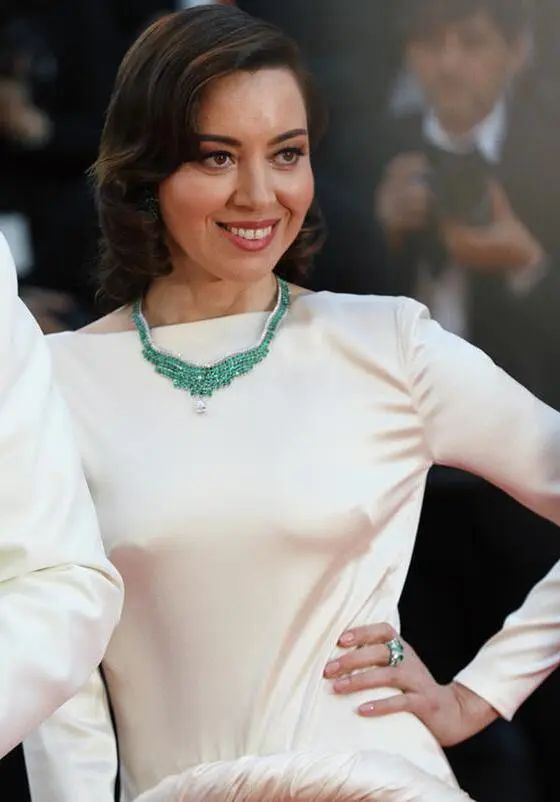
Emeralds have truly been “killing it” lately! From the Met Gala to the Cannes red carpet, these stunning green gemstones have been making their presence felt everywhere. Their inherent life-filled green color perfectly suits the spring and summer red carpet events, injecting a sense of calm and coolness amidst the excitement.
However, when you see celebrities like Cardi B and Demi Moore showcasing vastly different styles of emerald jewelry, you might wonder: what should one look for when buying emerald jewelry? Is it the enormous size, the prestigious origin, or the creative design? Today, let’s explore the different styles of emerald jewelry to help you make informed decisions.


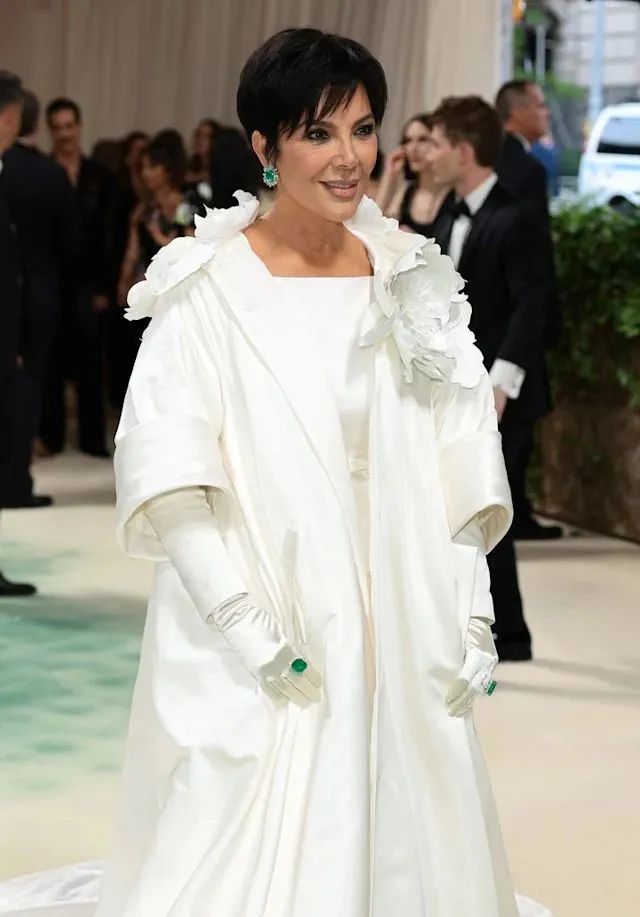
First, let’s clarify that the term “show-off style” used here is not derogatory; it’s simply an aesthetic trend in emerald jewelry, primarily popular in India but gaining acceptance elsewhere.
For instance, Cardi B’s choice at this year’s Met Gala – the “Garden of Time” necklace from Kamyen Jewelry – featured an emerald so large it stunned onlookers. The 141.71-carat Colombian emerald easily made her the center of attention.
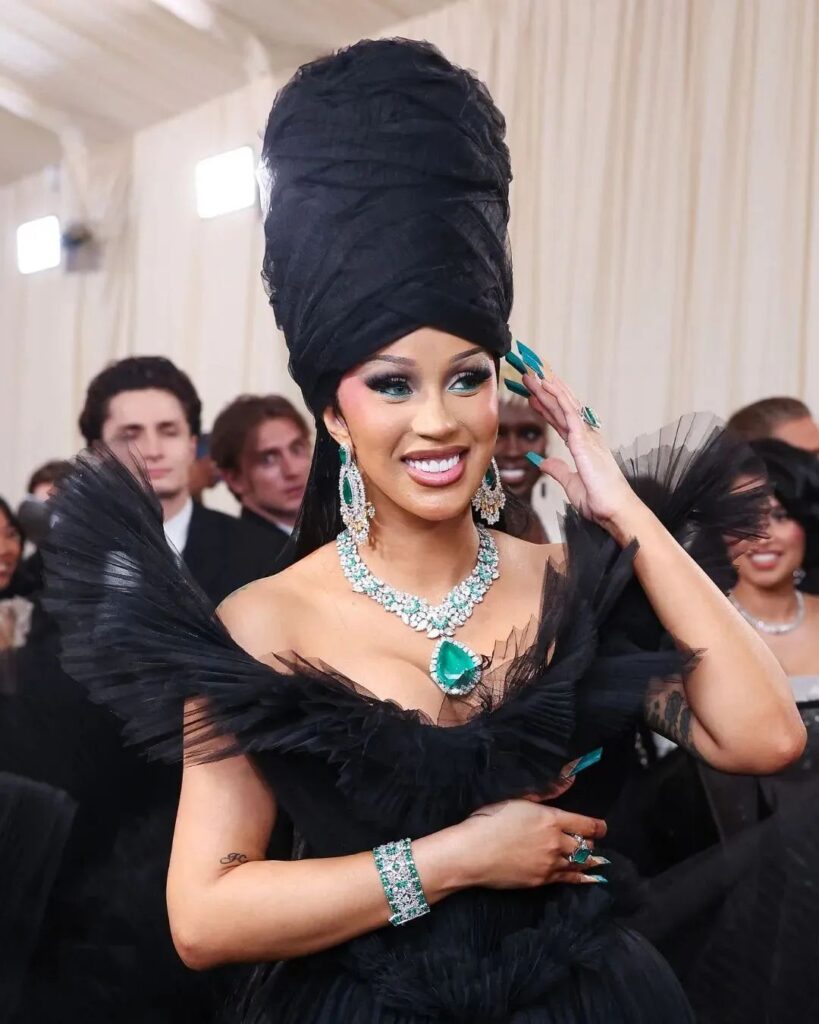
Kamyen Jewelry is a private Indian jewelry brand. Previously, their clientele was primarily Indian, but now they mostly cater to customers from the Middle East. It’s a family brand, and the current third-generation leader, Pooja Gandhi, explains: “We’re not interested in mass production, but we don’t focus solely on custom products either.
We prefer to offer ready-made pieces from our high-end collections. We participate in 3-4 international exhibitions annually, where clients can view our work by appointment.”
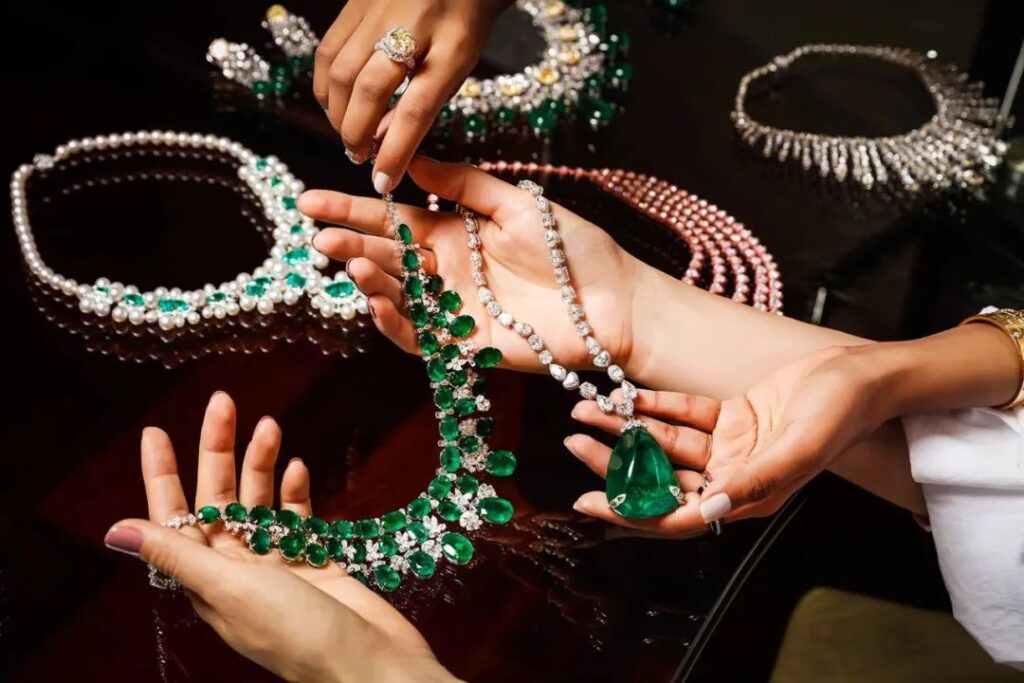
Jewelry designs featuring a large, high-quality emerald as the centerpiece are not uncommon in Western jewelry design. Bulgari, for example, often releases such pieces, but with a distinctly different style. Western jewelry designers tend to focus more on the overall balance and completeness of the piece, while Indian-style emerald designs usually have one purpose – to highlight the size of the emerald.

For instance, the emerald necklace worn by Nita Ambani, wife of India’s richest man, which went viral on social media and was jokingly referred to as the “Tiger Balm bottle,” features a massive and heavy emerald that undoubtedly captures your attention at first glance.
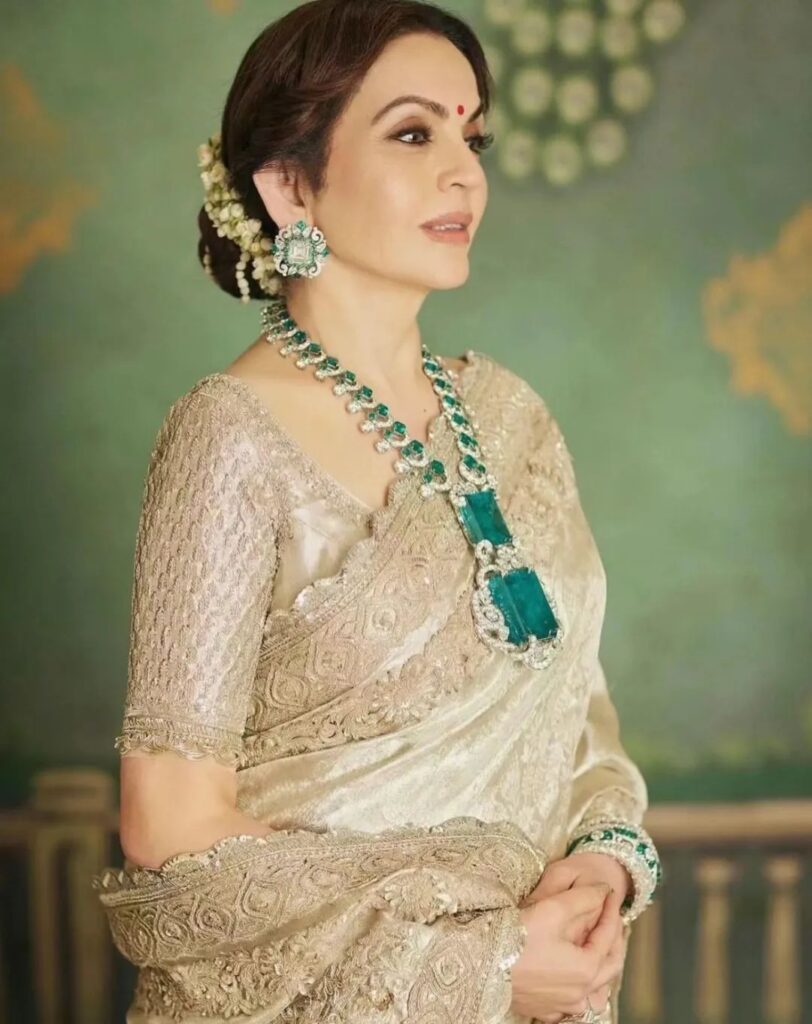
This undoubtedly reflects the jewelry taste passed down from Indian maharajas. As early as the 16th century, when Spaniards introduced Colombian emeralds to India, they quickly gained the admiration of Mughal emperors.
In Indian culture, verdant gemstones symbolize the power of life, and the larger the stone, the more it reflects the wearer’s devotion to the divine. The emperors also liked to engrave various religious patterns and prayers on emeralds, hoping to gain divine protection.
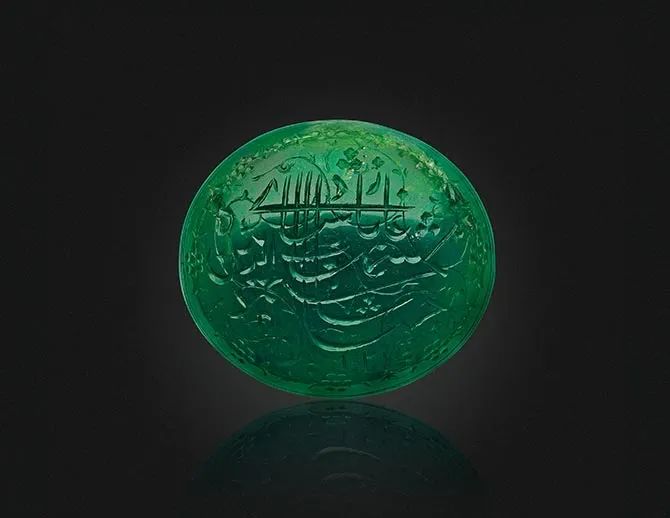
Take, for example, the famous “Taj Mahal” emerald, weighing about 141 carats. One side is plain, while the other is adorned with intricate carvings of chrysanthemums, lotuses, and Mughal poppies. Carved between 1630 and 1650, it originally belonged to Emperor Shah Jahan. Later, it was set by Cartier in the Collier Bérénice shoulder ornament, which was exhibited at the 1925 Paris Exhibition.

An even larger Mughal emerald, weighing 380.98 carats, was used by Cartier to create a Jigha mount for Maharaja Bhupinder Singh of Patiala. This emerald features double-sided carvings: the front depicts Rama, his wife Sita, and their faithful servant Hanuman, while the back showcases a poppy flower.
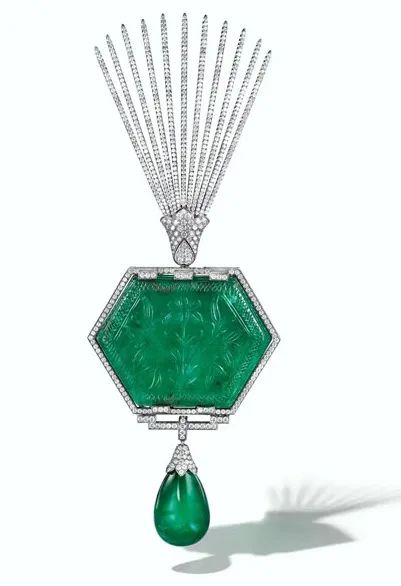
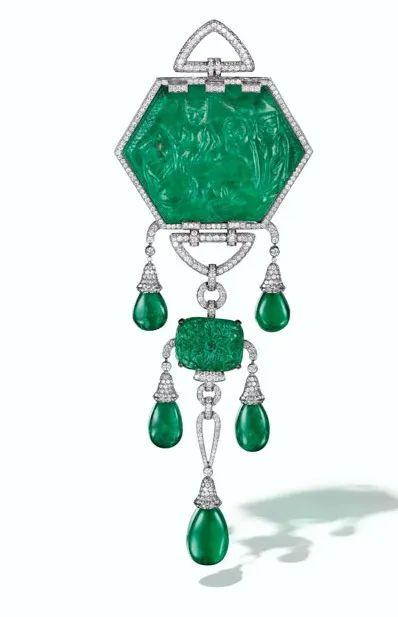
Cartier maximized the potential of this enormous Mughal emerald by designing it with two wearing options: as a traditional Indian Jigha, or as an Art Deco style brooch.
In modern times, Indian jewelry designers no longer prefer carving emeralds but retain their love for large sizes. They aim to preserve as much of the emerald’s carat weight as possible, paying less attention to cutting or setting. In Nita Ambani’s other emerald jewelry pieces, we can see many pear-shaped emeralds, mostly cut to follow the stone’s natural shape, with little concern for maintaining consistent outlines.
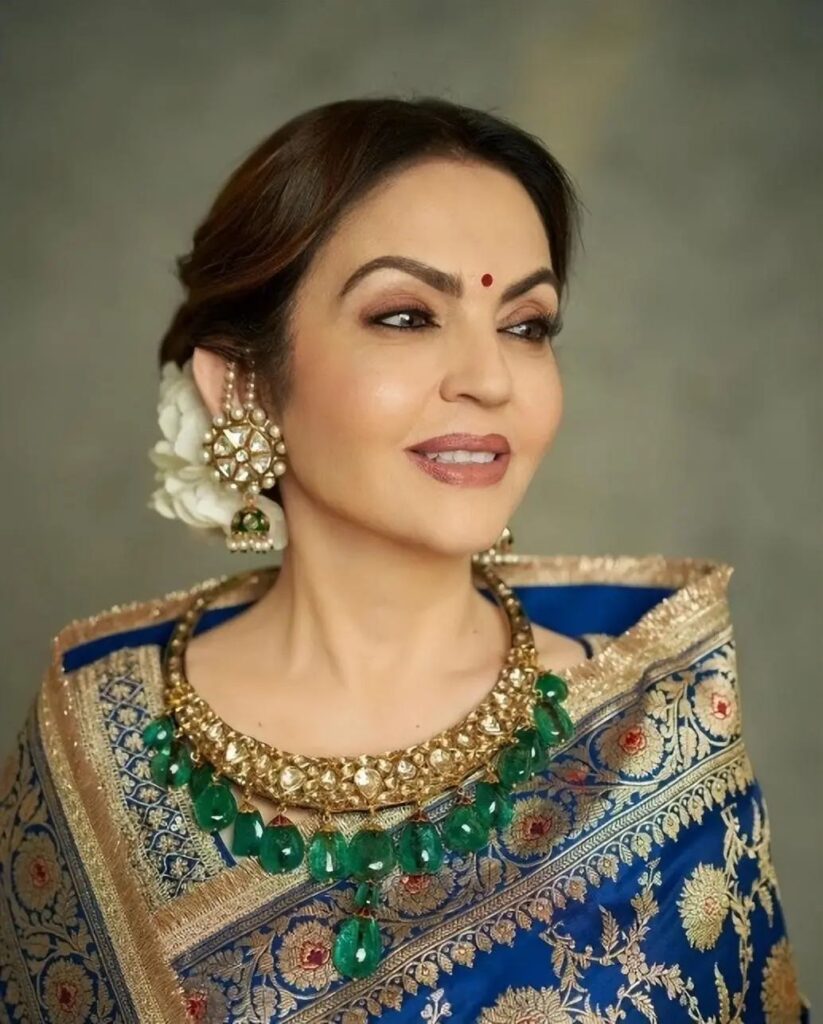
In the 16th and 17th centuries, the emeralds owned by Indian maharajas all came from Colombia, as other sources had not yet been discovered. This is one reason why these emeralds fetch astronomical prices at auctions today – Colombia is the world’s premier source of high-quality emeralds. Many collectors prioritize this “noble” origin above all else, with Colombian Muzo emeralds being the most coveted.
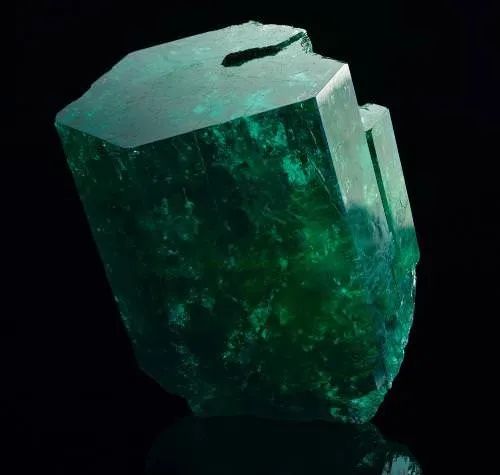
Muzo emeralds are prized for their pure color, high transparency, and tendency to occur in large carat sizes. However, emeralds from two other Colombian mines, Chivor and Coscuez, are equally impressive, each with its own color characteristics.
Chivor emeralds have a bluish tint, giving them a cool, translucent quality, while Coscuez emeralds have a yellowish tint, resulting in a brighter green. All three major Colombian emerald mines have been famous since the 16th century for producing top-quality emeralds.
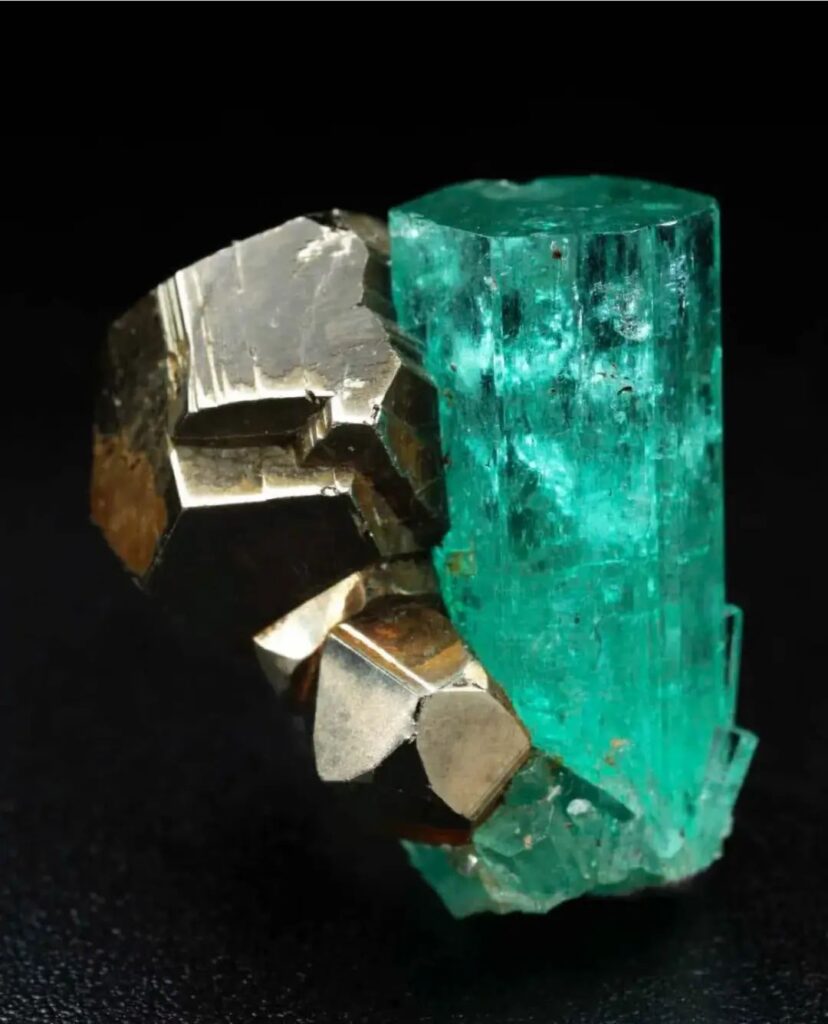
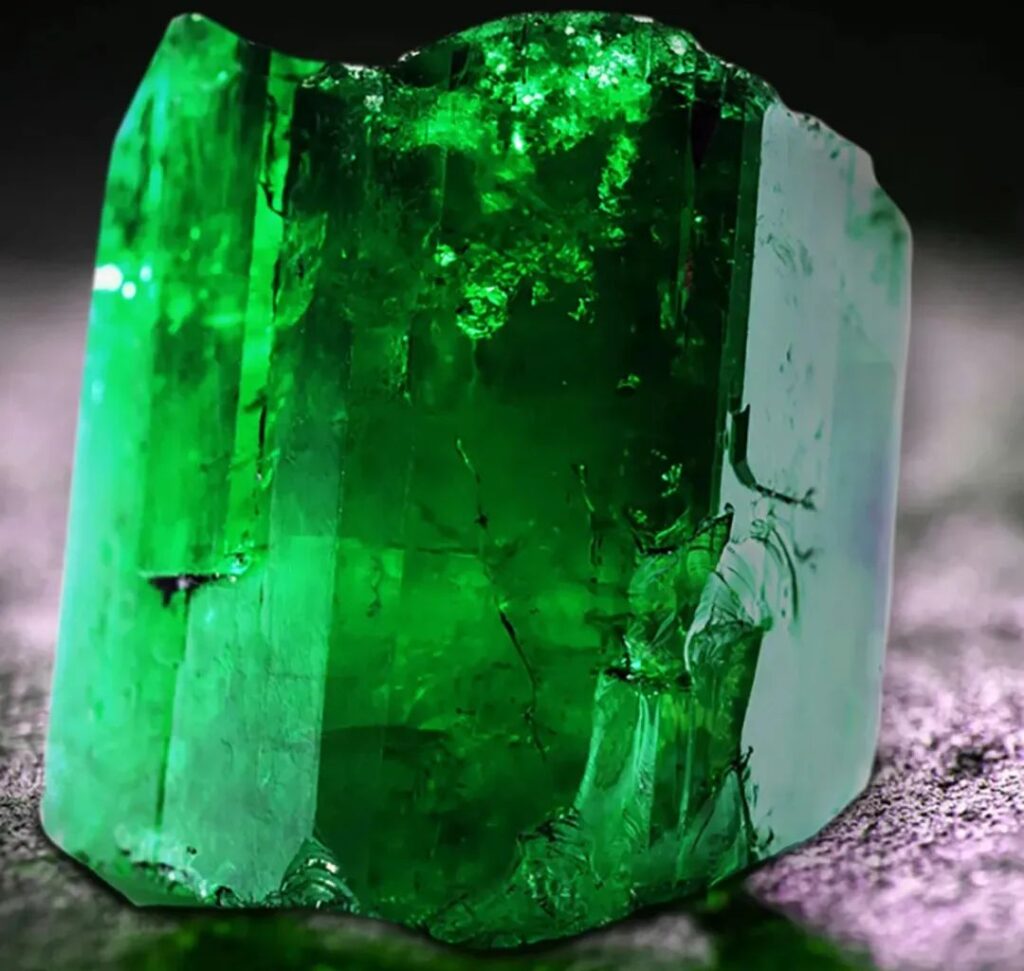
Today, emeralds from Brazil, Zambia, and Afghanistan are also available in the market, but they were discovered much later and each has its own “shortcomings.” For instance, Brazilian emeralds often have a grayish tint and lower transparency, with only a small percentage suitable for high-end jewelry.

4.26 carats and 4.13 carats
Christie’s Hong Kong, March 2022
Estimate: HKD 150,000-250,000
Sold for: HKD 201,600
Afghan emeralds boast excellent color and transparency, but they were discovered relatively recently, with the Panjshir Valley emerald mines only coming to light in recent years. Most Afghan emerald rough is pencil-shaped, rarely producing large carat stones. Their most significant drawback is the mine’s location in a conflict-prone area, making consistent production difficult to guarantee.
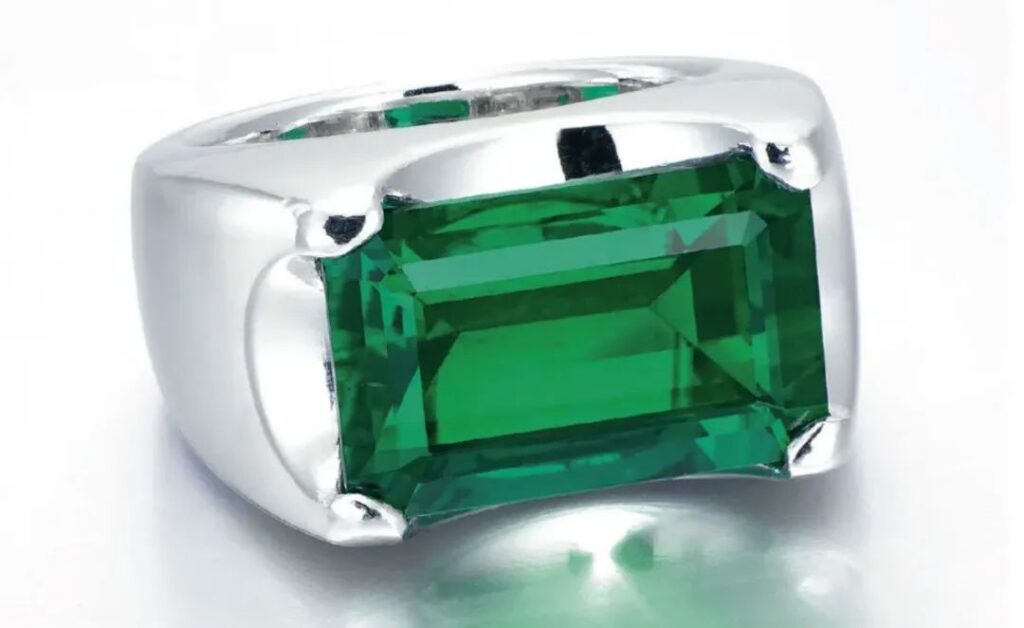
Christie’s Hong Kong, December 2015
Estimate: HKD 8,000,000-12,000,000
Sold for: HKD 17,560,000
The new rising star, Zambian emeralds, although only discovered in the 1970s, are comparable to Colombian emeralds in color, clarity, and carat size. They contain iron, which can give them a slightly grayish appearance, resulting in slightly lower brightness. However, their higher production rates make it easier to find exceptional stones, leading to their increasing popularity in high-end jewelry circles in recent years.
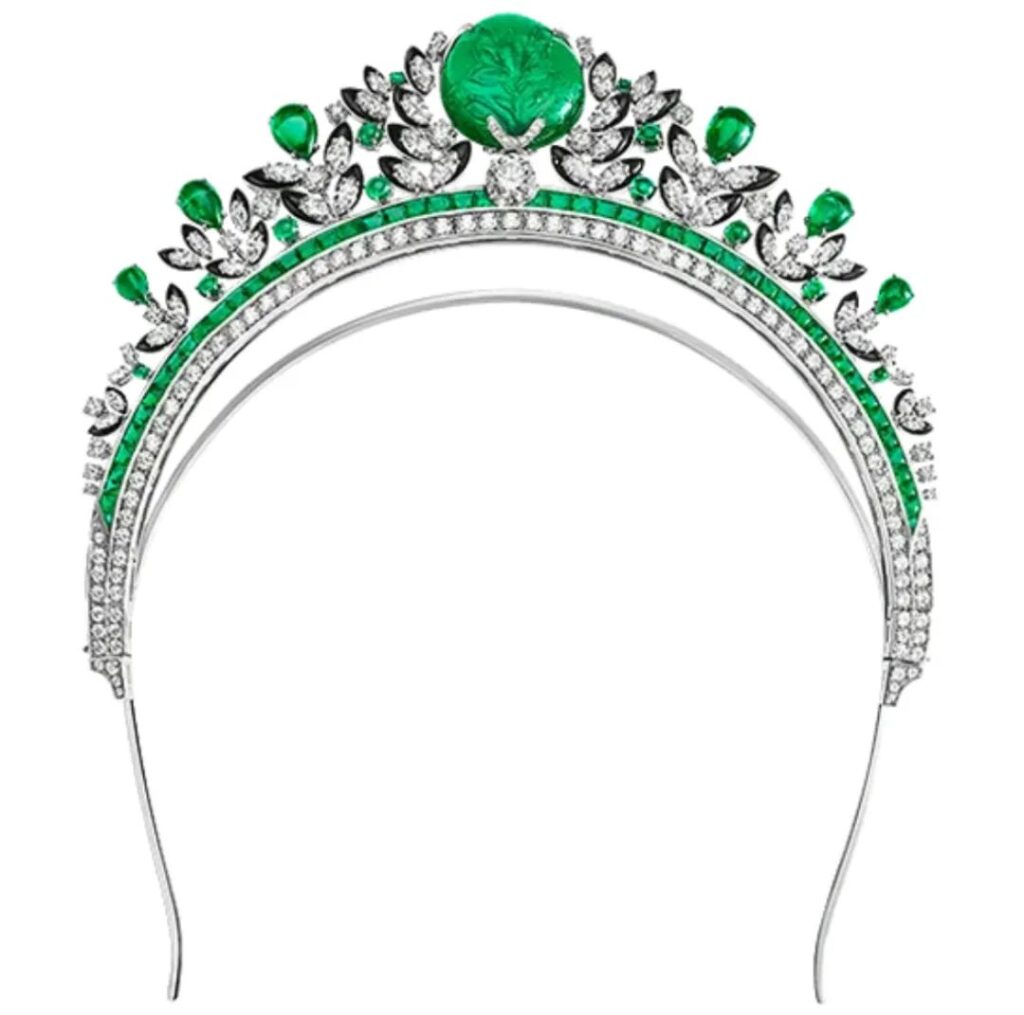
Colombian emeralds, therefore, remain superior in overall quality, considering color, clarity, and weight, making them synonymous with top-tier emeralds. So, who are the major collectors of Colombian emeralds?
Naturally, it’s the European royal families, who have always been keen to display their status! Colombian emeralds gained fame earliest, and during the era of absolute monarchy, the world’s finest gemstones were inevitably presented to royalty.
Consequently, every royal family has emerald jewelry collections, which, given their quality and age, are undoubtedly Colombian emeralds. This is especially true for the emeralds adorning crowns that symbolize their status – each more richly colored and larger than the last.

The British Royal Family owns the famous “Cambridge Emeralds,” which can be traced back to 1818. Queen Mary nearly risked her reputation to acquire these gems, and rumors persist about her “snatching” these jewels from her brother’s wife.
For the 1911 Delhi Durbar coronation ceremony in India, Queen Mary commissioned Garrard to create a new set of jewelry using these “Cambridge Emeralds,” including a crown, necklace, stomacher brooch, and earrings.
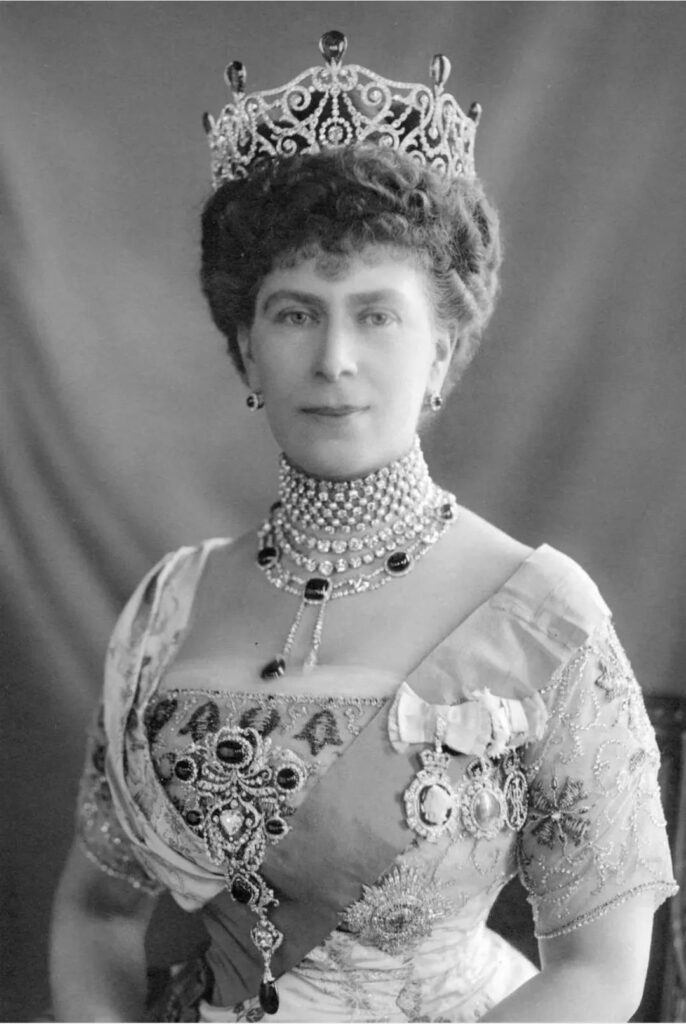
A few years later, Queen Mary purchased the Vladimir Tiara from the daughter of Grand Duchess Maria Pavlovna of Russia. She then removed the Cambridge emeralds from the Delhi Durbar crown and suspended them from the Vladimir Tiara. This more modern tiara later became a favorite of Queen Elizabeth II.
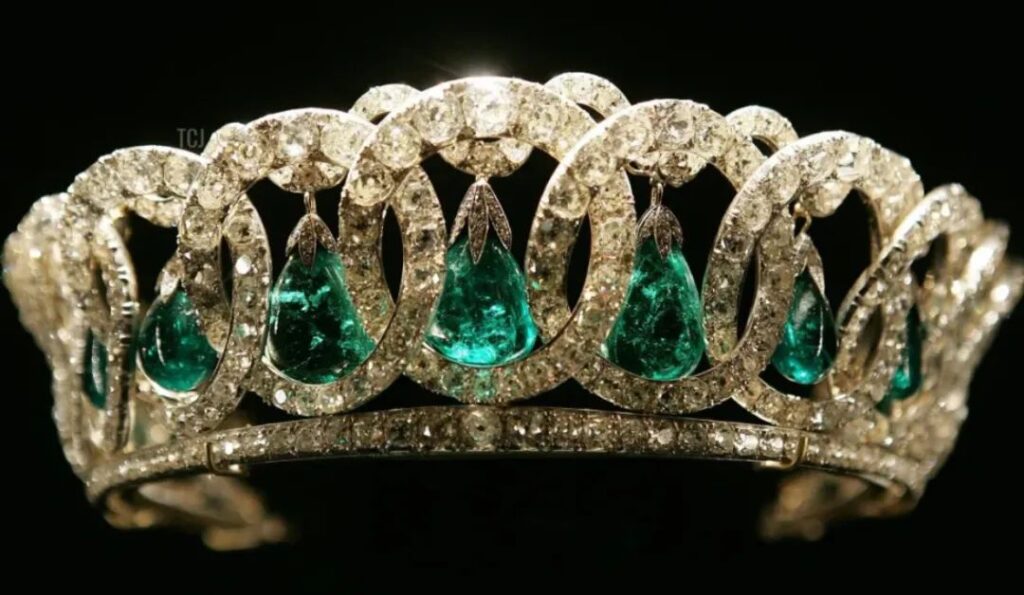
The French Royal Family possessed the Angoulême Emerald Tiara, commissioned in 1820 by Princess Marie Thérèse, Duchess of Angoulême and daughter of Louis XVI, from Bapst. Empress Eugénie later wore it. After the French royal family’s exile, it was auctioned along with other royal jewels, only returning to France this century, now housed in the Louvre Museum.
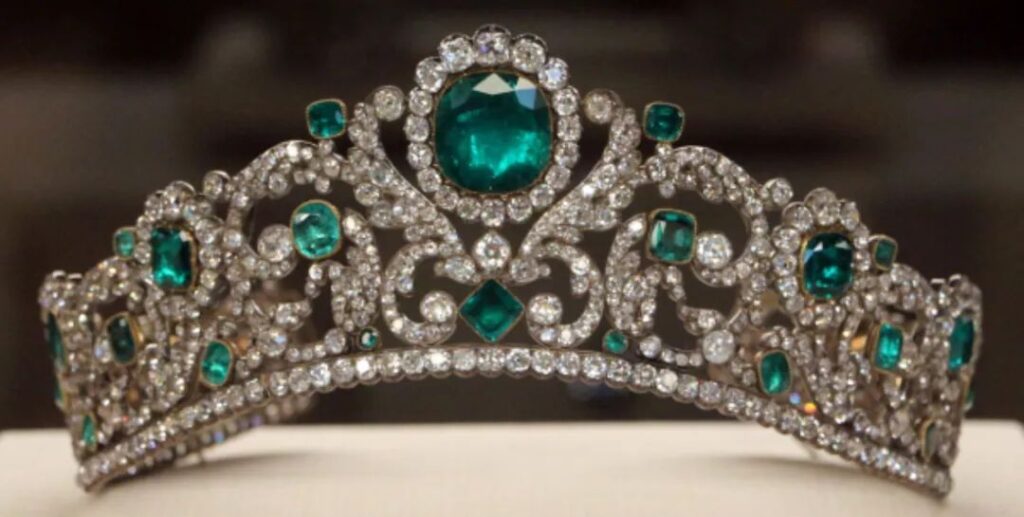
Another emerald set originally belonging to the French royal family made its way to Norway through marriage. This complete parure, set with many large-carat Colombian Muzo emeralds, initially belonged to Empress Joséphine.
She left it to her son, and it eventually passed to Queen Joséphine of Sweden and Norway, née Leuchtenberg. Since then, the emerald parure has remained with the Norwegian royal family, hence its name, the Norwegian Emerald Parure.

The Iranian royal family’s love for emeralds is noteworthy. Most of their jewels date back to the Safavid dynasty, which ruled Iran from 1502 to 1736. The most famous pieces were created by Van Cleef & Arpels, commissioned by Iran’s last king using royal collection gems.
The coronation crown of the last queen, Farah, is a prime example. This crown is set with over 38 emeralds, 105 pearls, 34 rubies, 2 spinels, and 1,469 diamonds. The most precious gem is undoubtedly the centerpiece – a 150-carat faceted hexagonal emerald.

Of course, the coronation crown was worn only once in Queen Farah’s life. Her most frequently worn emerald tiara was the “Seven Emerald Tiara” designed by Harry Winston. This tiara features a base of white, yellow, and pink diamonds, topped with 7 large cabochon emeralds, all sourced from the Iranian royal collection.

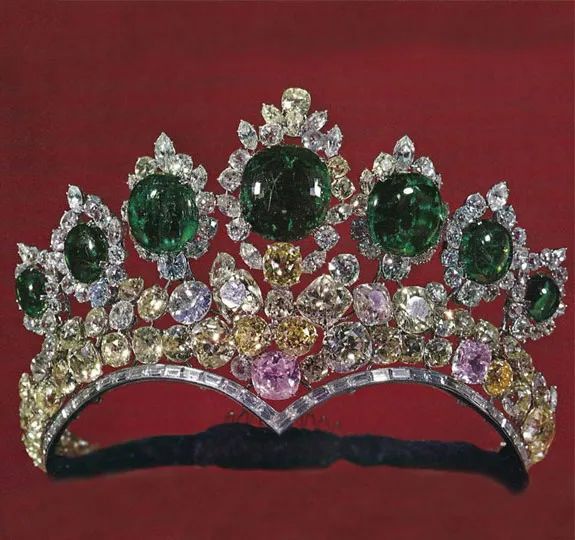
While royal jewelry collections often represent the collective efforts of generations and prioritize rare gemstones themselves, socialites who became active in jewelry collecting circles in the 20th century had different motivations.
They preferred jewelry designs that showcased taste and personality. Creating unique pieces featuring beautiful emeralds to set trends in social circles became a point of pride. As a result, major jewelry brands contributed endless creativity in the 20th century, leaving numerous classic works in jewelry history.

How did these socialites showcase emeralds? They selected the most distinctive designs, and during the Art Deco period, Cartier’s application of carved emeralds led a new trend. Cartier collected various historically significant and exotic carved emeralds from Indian maharajas, redesigning them.
The Sarpech (turban ornaments) and ornate belt buckles once worn by the maharajas were reinterpreted with geometric patterns and reset as brooches or necklaces.

For instance, the famous American socialite Marjorie Merriweather Post owned numerous emerald jewels. Two of her brooches featured carved emeralds from Indian rulers as the centerpieces.
These high-quality Colombian emeralds mostly entered the collections of Indian rulers in the 17th century and were carved with various Indian cultural motifs by their court artisans. Common patterns included poppies, lotuses, irises, and other floral designs.
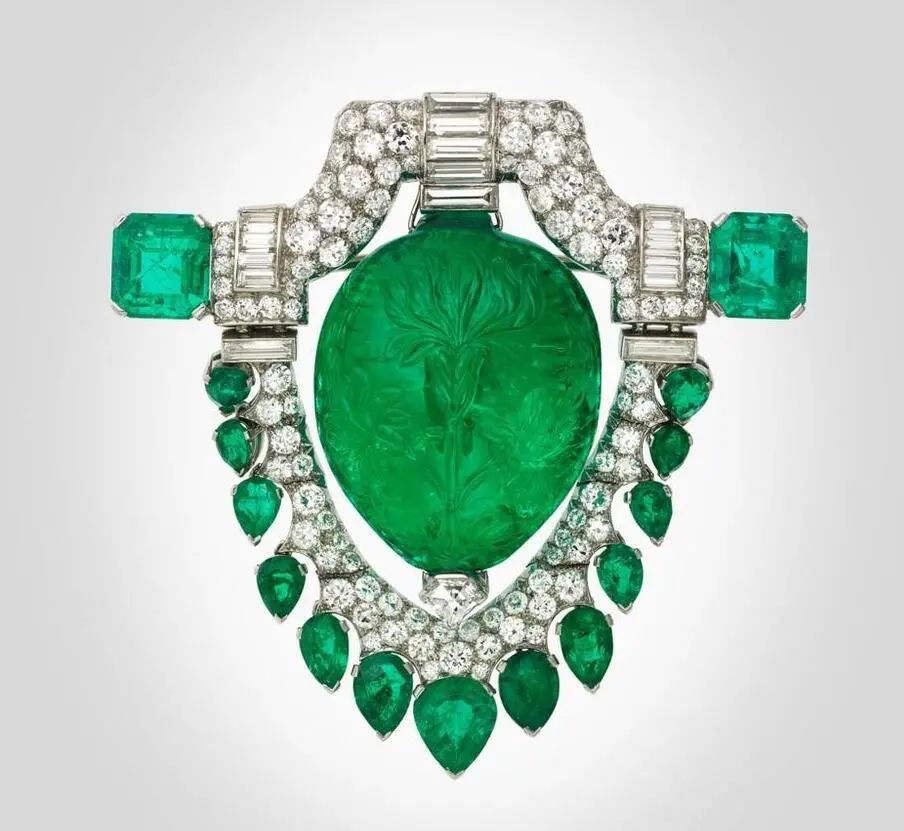
The most famous emerald piece in Marjorie’s collection was a Cartier brooch made in 1928. It was set with approximately 250 carats of Mughal-era carved emeralds. Cartier combined these ancient emeralds with diamonds and onyx to create a versatile piece that could be worn as both a brooch and a necklace pendant.

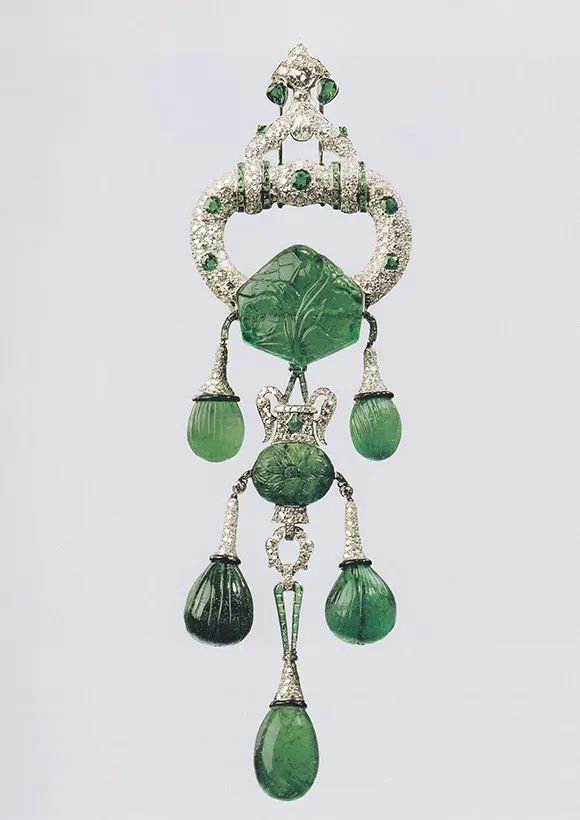

Cartier also created a matching emerald necklace for her, set with 24 emerald beads cut to follow their natural shape. When worn together, the necklace and brooch exuded a unique blend of Eastern and Western cultures. Marjorie once wore them to a costume party where she dressed as “Juliet,” strangely complementing the classical beauty of the Renaissance period.
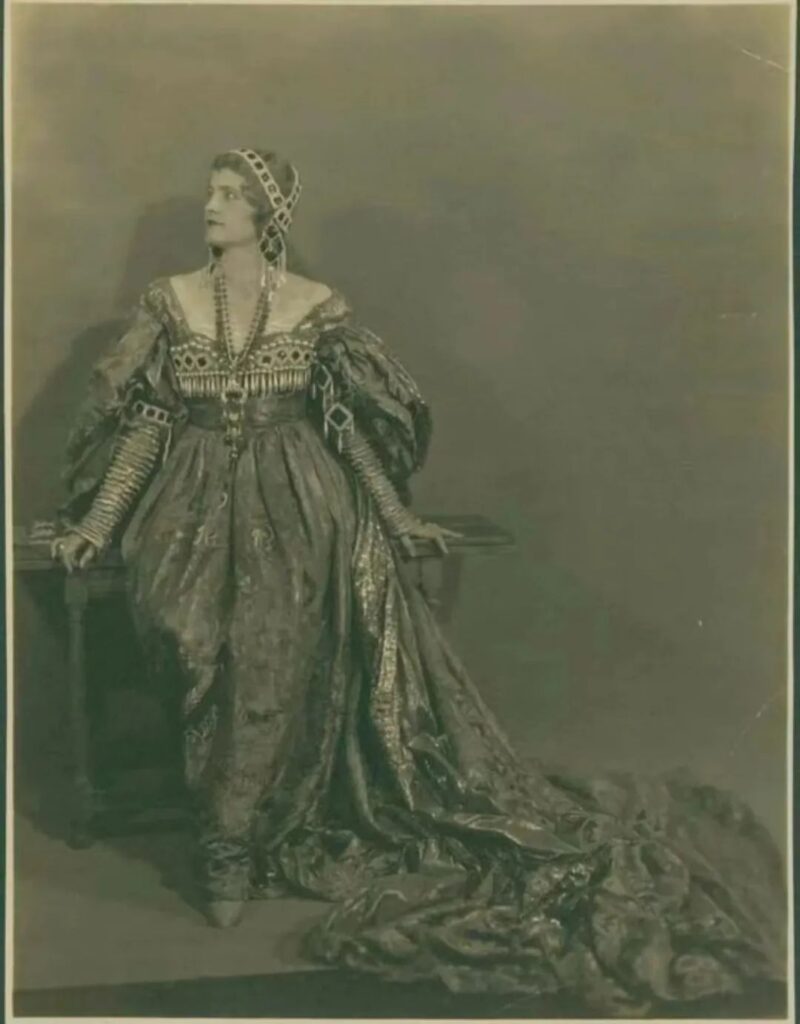
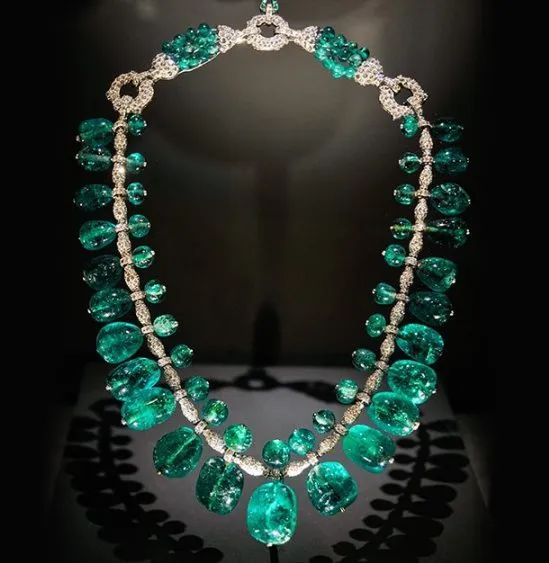
Van Cleef & Arpels had a distinctly different approach to using emeralds compared to Cartier. They preferred pairing sparkling diamonds with non-faceted emeralds, which both highlighted the rich color of the emeralds and showcased the brilliance of the diamonds.
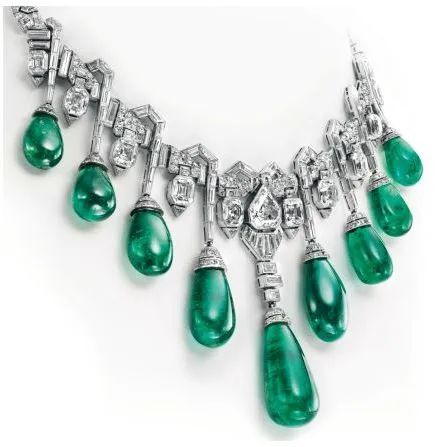
For example, this emerald necklace designed by Van Cleef & Arpels in 1929 for Egyptian Princess Fawzia Fuad featured 10 teardrop-shaped cabochon emeralds. The upper diamond chain section was composed of geometric lines, strongly reflecting the Art Deco style, while the dangling emerald drops softened these sharp angles, creating a beautiful contrast between nature and modernity.
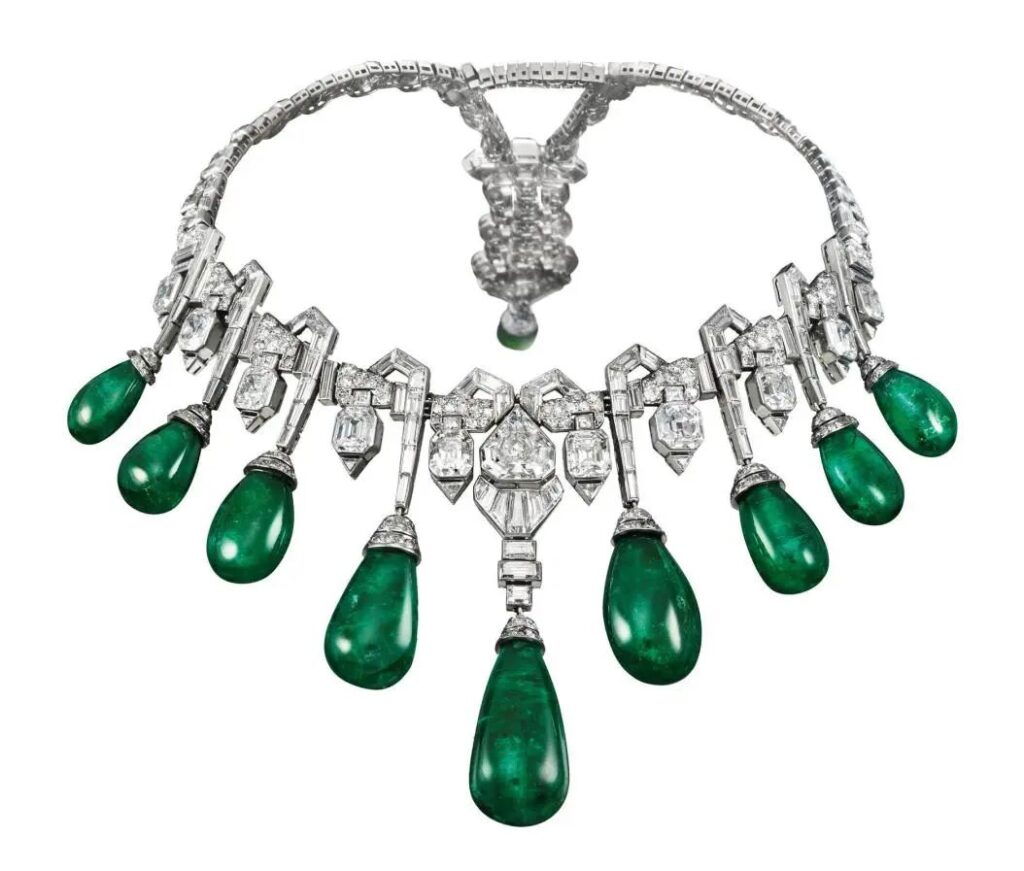
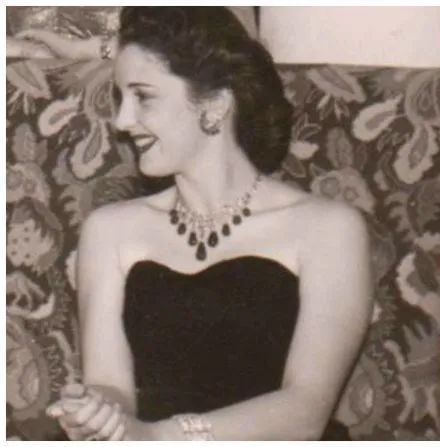
In 1935, Van Cleef & Arpels also designed an emerald choker necklace for American socialite Hélène Beaumont, employing a similar creative approach. They set 11 sugarloaf-cut emeralds within geometric patterns formed by diamonds, creating a unique three-dimensional effect. This necklace could also be separated and worn as two bracelets.
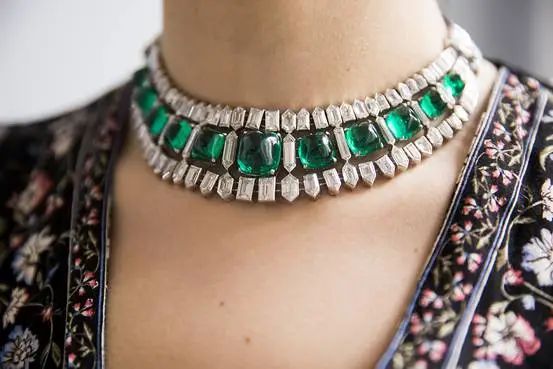

This design style by Van Cleef & Arpels was quite popular at the time, with many socialites acquiring similar diamond and emerald designs. Jacqueline Kennedy also owned a similar emerald necklace, a gift from Greek shipping tycoon Aristotle Onassis. The necklace featured abstract floral designs in diamonds, from which hung five Colombian emerald drops of varying sizes, accompanied by a rare cabochon-cut emerald brooch.
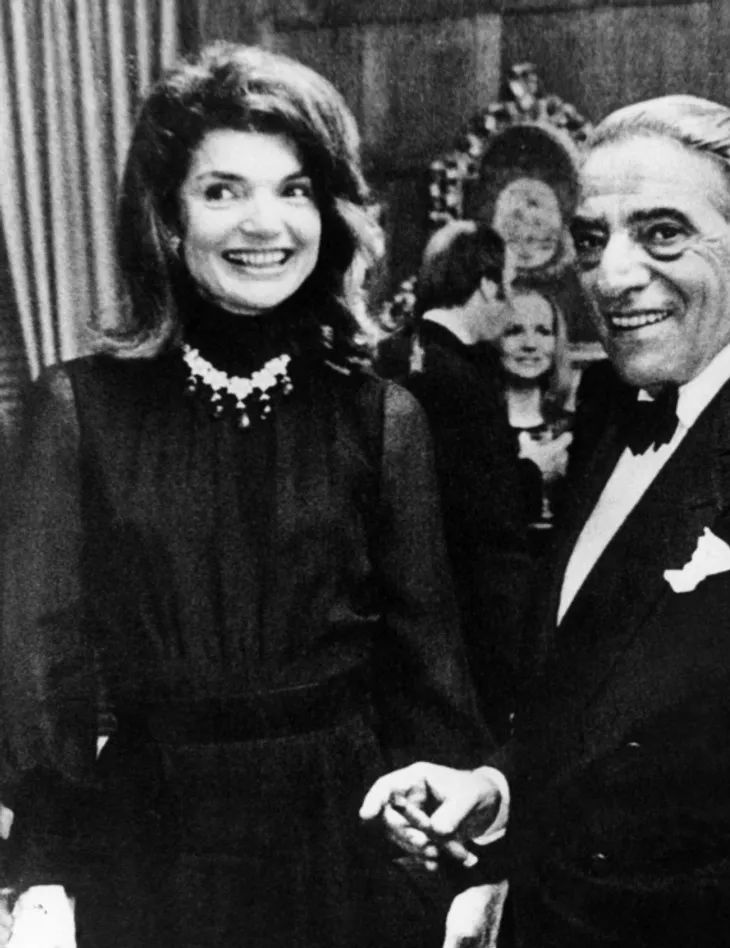
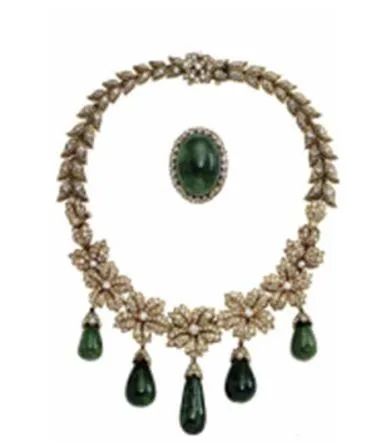
This necklace was clearly influenced by the emerald and diamond necklace Van Cleef & Arpels designed for the Maharani of Baroda. It featured diamond-set lotus patterns, a popular motif in Indian culture, paired with large teardrop-shaped emerald beads.
In 1946, the Maharani of Baroda approached Jacques Arpels with her stunning gem collection, requesting him to redesign her ancient Indian-style jewels. Thus, this former Indian princess transformed into Sita Devi, a trendsetting Parisian socialite, engaging in a jewelry rivalry with the Duchess of Windsor.
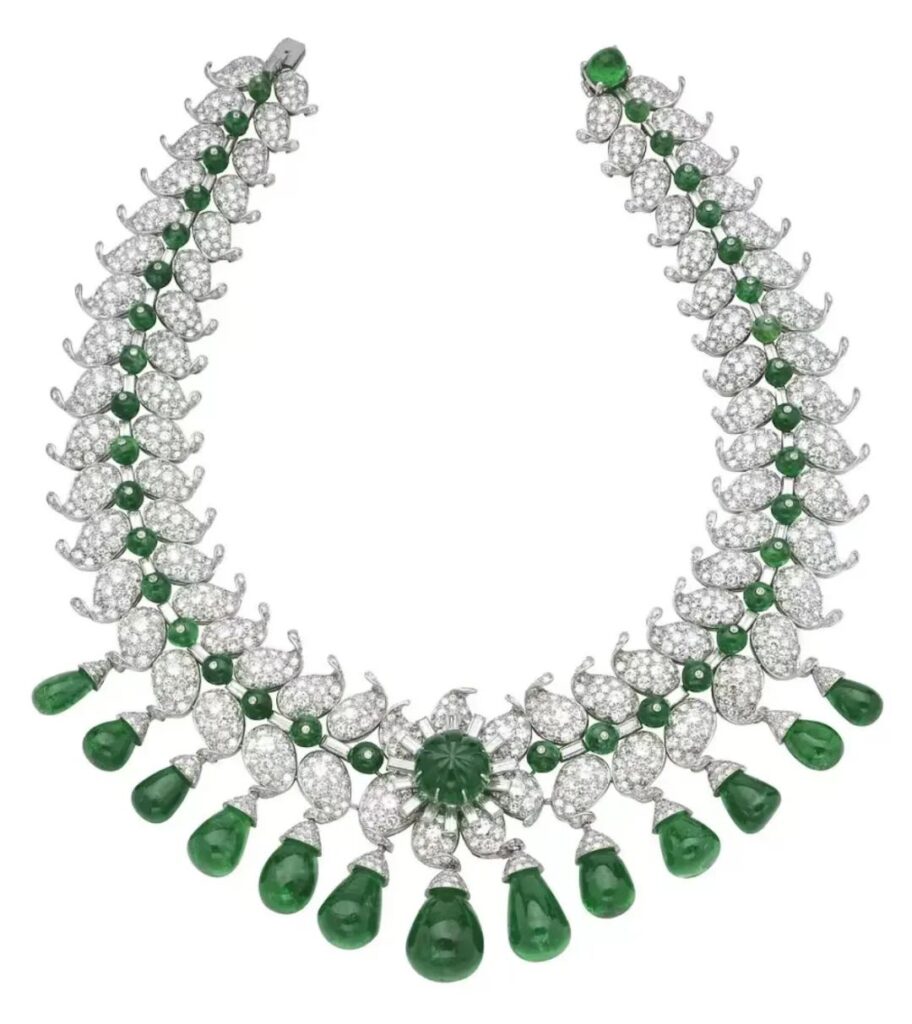
American socialite Brooke Astor also had a fondness for emerald jewelry. As her surname suggests, she came from the famous Astor family and was often referred to as “the last bridge to the Gilded Age” during her lifetime. This philanthropic socialite maintained an impeccable appearance at all public events, with jewelry being her indispensable companion.
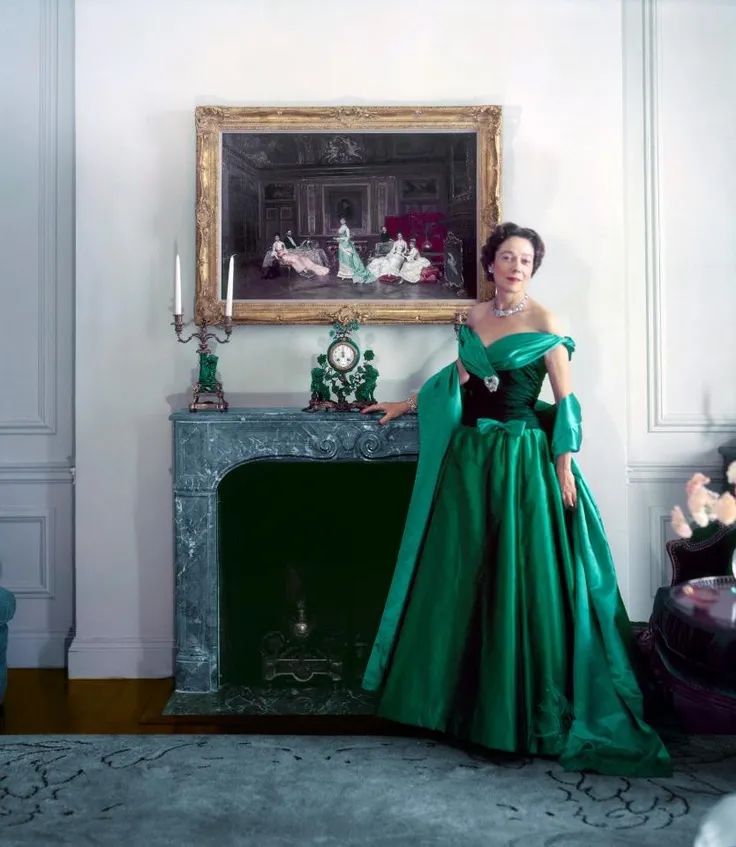
She particularly loved emeralds and favored designs with a classical flair. For instance, the Bulgari emerald and diamond necklace given to her by her husband, Vincent Astor. Created in 1959, this necklace boasted a modern yet vintage style, featuring 13 pear-shaped emeralds (71 carats) and 14 cabochon emeralds (41 carats) surrounded by diamonds of various cuts.
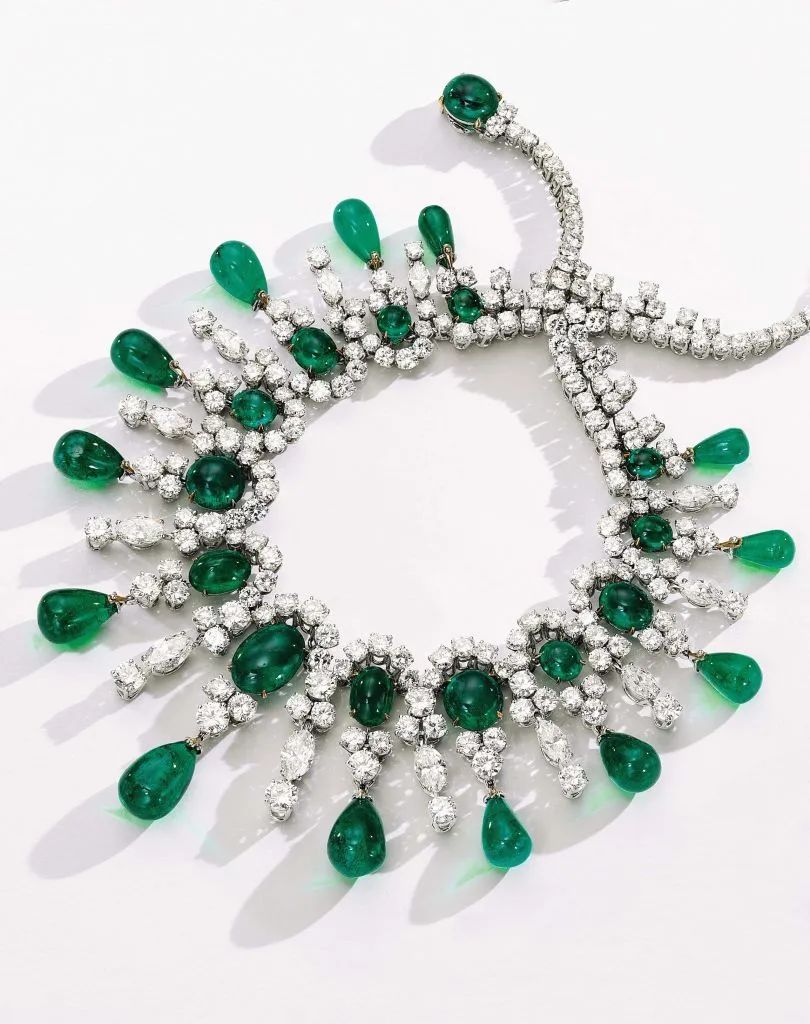
Early Bulgari high jewelry creations drew inspiration from traditional French jewelry craftsmanship. As the brand expanded internationally, they designed tiaras and large jewelry pieces for many royals and socialites.
In the 1960s, Bulgari’s emerald designs leaned towards a modern interpretation of classical court style. They used cuts that best suited emeralds – emerald cuts or step cuts – with simple facets to showcase the unique “garden” charm of emeralds.
Diamonds served as glamorous accents surrounding the green gems, creating a luxurious and splendid court style. The most representative works of this period were undoubtedly Elizabeth Taylor’s “love gifts.”
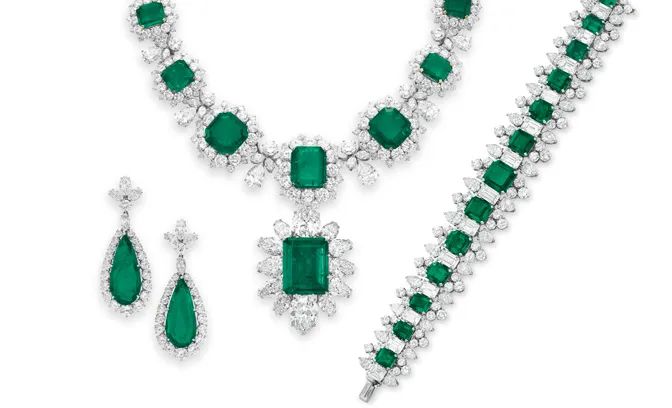
Elizabeth Taylor’s first Bulgari emerald piece was a tremblant brooch, a gift from her fourth husband, Eddie Fisher. It had a slightly naturalistic style, and she often wore it in unconventional ways, such as in her hair or on a shoulder strap.
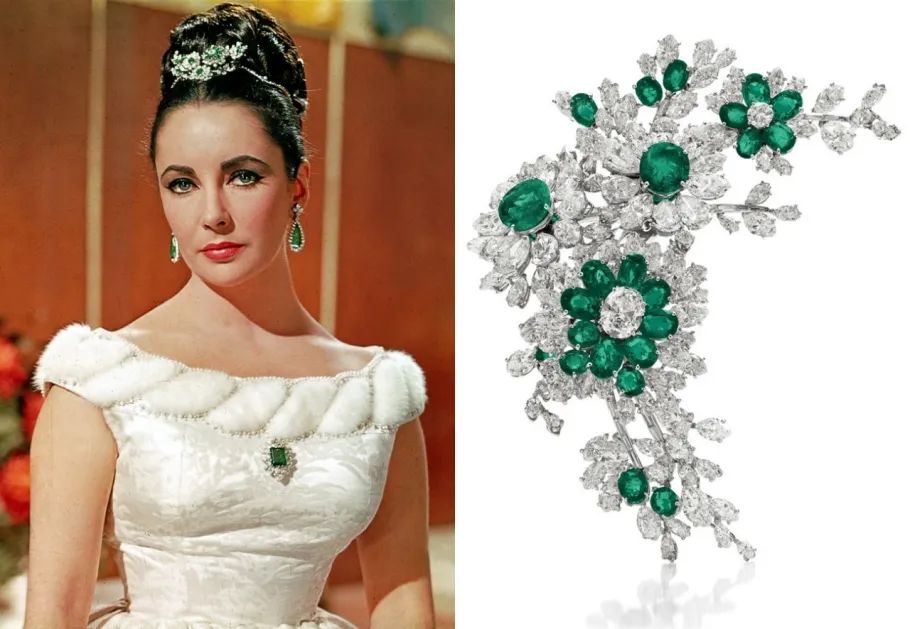
When her great love Richard Burton came into her life, they fell in love on the set of “Cleopatra,” which conveniently allowed them to seek love tokens at the Bulgari store. Richard Burton bought Elizabeth this magnificent vintage-style emerald necklace, set with 16 graduated emerald-cut emeralds, each surrounded by round, pear-shaped, and marquise-cut diamonds.
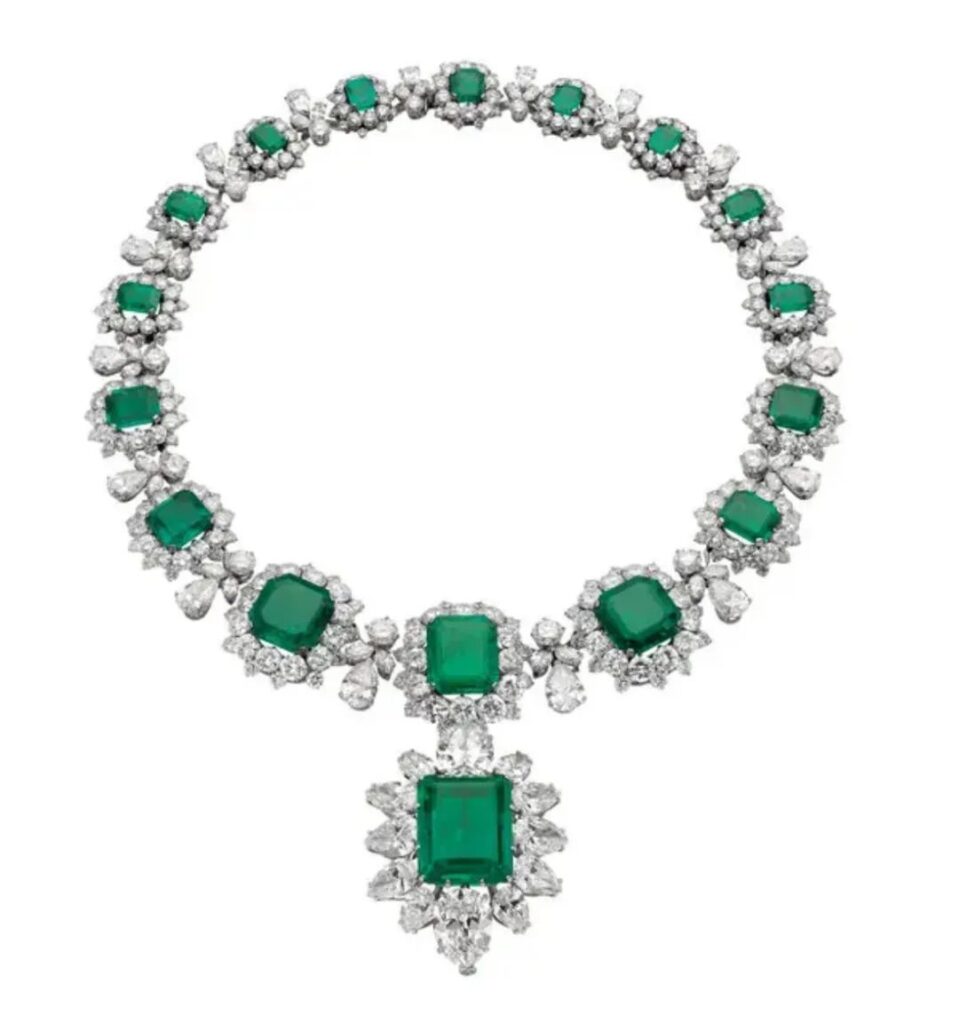
The pendant brooch that could be worn with the necklace was possibly the largest piece added to Elizabeth’s already extensive collection. It featured a 23.46-carat emerald-cut Colombian emerald surrounded by 12 pear-shaped diamonds. In 2011, this piece sold for an astonishing $6,578,500 at Elizabeth Taylor’s estate auction, setting a world auction record for an emerald jewel, with the per-carat price of the emerald reaching $280,000.
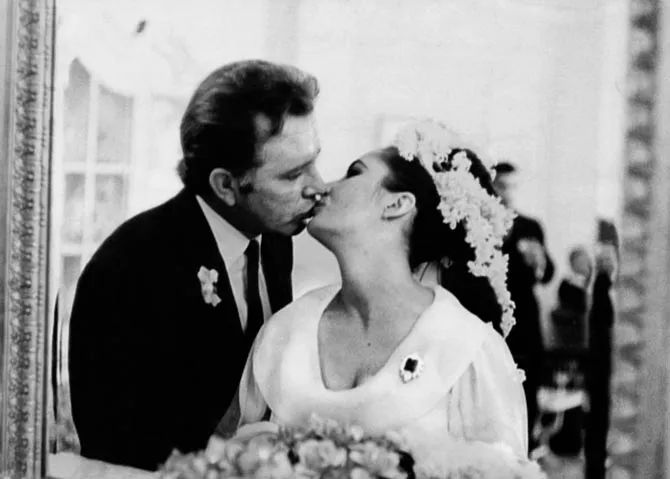

To complete the emerald set, Richard Burton subsequently purchased the “Taylor-Burton Engagement Ring,” pear-shaped emerald earrings, and a bracelet matching the necklace for Elizabeth.

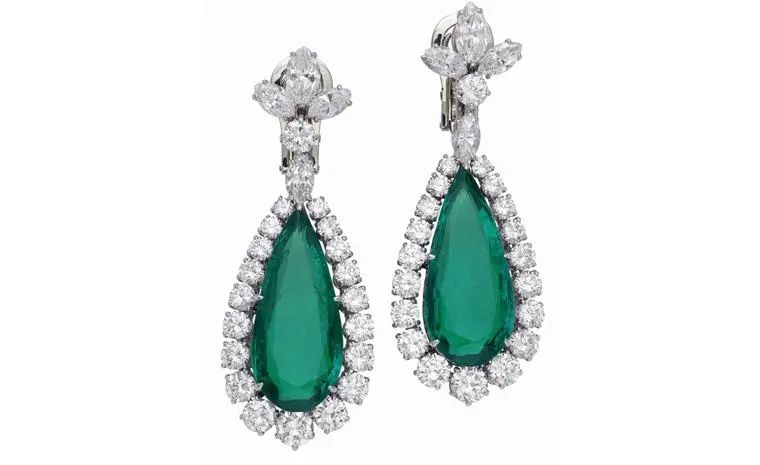
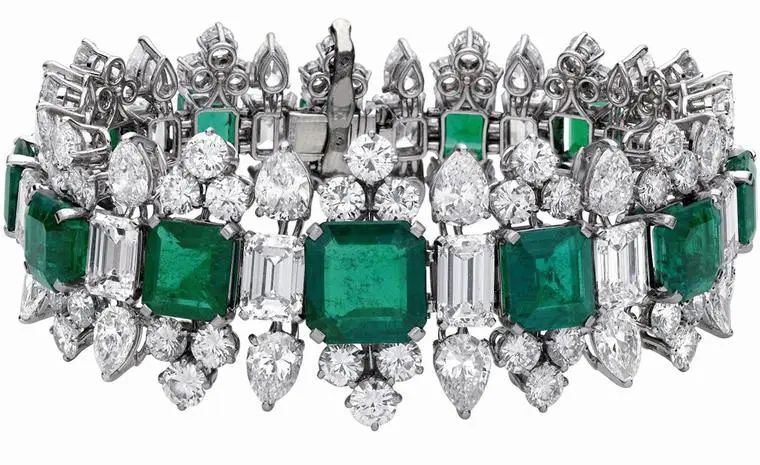
Having read this far, jewelry collectors might wonder: when acquiring emerald jewelry, should one prioritize size, origin, or design?
The principle remains the same: act according to your needs and means. I always maintain that jewelry should first and foremost be beautiful to wear, fulfilling its aesthetic value, before considering its investment potential. After all, if you’re truly looking to invest, it might be better to buy gemstones directly!
Emeralds Reign Supreme on the Red Carpet: Which Matters Most – Origin, Color, or Size?
Tweet
